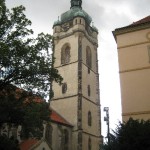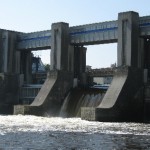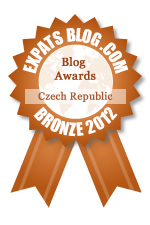
'Arbeit Macht Frei' - 'Work makes you free' - the ironic inscription over an archway in the small fortress at Terezín © Ricky Yates
The imposing fortress and small town of Terezín lies about 80 km north of Prague. It is situated at the strategic location of the confluence of the Labe (Elbe) and Ohre (Eger) rivers and was constructed on the orders of the Austro-Hungarian Emperor Joseph II in order to keep the Prussians at bay. It was formerly known as Theresienstadt in honour of the Empress Maria Theresa. On the eastern side of the Ohre lies the original small fortress whilst on the western side there is a far larger fortress within which there is a small town with a sizeable central square and a grid iron pattern of streets.
In 1940, soon after the outbreak of the Second World War, the Gestapo took over the small fortress to use as a prison. A year later, the resident population of about 3000 people were evicted from the town inside the main fortress and the whole complex was then turned into a transit camp for European Jews as part of Hitler’s ‘final solution‘.
Over the following four years, more than 140,000 Jews passed through Terezín. Around 33,000 died here because of the appalling cramped conditions. At one point, there were over 58,000 inmates in a town that previously had a population of 3000! More than 87,000 were sent on to their death in concentration camps further east, in particular to Auschwitz. Only around 17,000 survived and some of these died from an outbreak of typhus around the time the camp was liberated by the Red Army in May 1945.
Ironically, despite the horrific role Terezín played in the Jewish holocaust, it was also used as a vehicle for Nazi propaganda and portrayed to visitors from the International Committee of the Red Cross as a self-administering ‘Jewish Refuge’. Despite the awful conditions, there was an amazing amount of community life with plays and concerts being performed and artwork and literature produced.
The Terezín Memorial was established in 1991 in order to retell the story of what happened here, to preserve and display art and literature produced by those interned, and to preserve numerous buildings including the crematorium, a fascinating Jewish Prayer room with Hebrew inscriptions from the Psalms on the walls, together with the whole of the small fortress, little changed from how it was in 1945.
Terezín had been on Sybille’s and my list of places to visit since we moved to the Czech Republic. Therefore when my sister Jenny stayed with us recently and also expressed an interest in going there, we took the opportunity to do so. It is not an enjoyable day out – far from it. Rather it is quite a sobering experience but certainly one I’m very glad I’ve experienced.
There is an excellent museum in two parts. The Ghetto Museum itself tells the story of Terezín and puts it in the context of the wider events of the Second World War. Then within the nearby Magdeburg Barracks there are displays of the amazing cramped conditions in which internees were forced to live, as well as displays of artwork, music and literature, all of which was produced in these appalling circumstances. You can then walk around the town to visit the other sites including exploring the whole of the small fortress. Everything is explained in four languages, Czech, German, English and Hebrew, and for once, the English is excellent with hardly any examples of that peculiar language I call Czenglish.
Terezín is a slightly eerie place and it must be somewhat strange for the nearly 3000 people who once again reside in the town to be surrounded by all this horrific relatively recent history. But as the seventieth anniversary of the outbreak of World War Two is currently being marked in Poland and elsewhere, it is important that all that happened at Terezín is preserved and re-told to the next generation.

National Cemetery in the foreground of the Small Fortress, Terezín © Ricky Yates





Excellent post, Ricky. And you’re right: such places must be preserved, and what happened there never forgotten. I think Holocaust Memorial Day is an excellent initiative. Remember a performance of ‘Kaddish for Terezin’ performed in London years ago @ charity concert (Leighton House for MNDA) by a friend who had been an opera singer in Israel … very moving, if you get a chance to hear it.
“Ricky Yates” has been included in this weeks Sites To See. I hope you like the image I featured, and I hope this helps to attract many new visitors here.
http://asthecrackerheadcrumbles.blogspot.com/2009/09/sites-to-see_11.html
“It is not an enjoyable day out – far from it. Rather it is quite a sobering experience but certainly one I’m very glad I’ve experienced.” You certainly grabbed my experience of Terezin from when I was there. Seeing the yellow “Arbeit Mach Frei” door still has the power to sober me up.
Great report on Terezín. It’s peculiar how “Arbeit mach Frei” is quoted in different languages across Europe. I guess this propaganda used to work in the industrial era.
I have seen holocaust sites as well as slave castles on the coast of west africa. I know the sobering feeling you are talking about. you can feel the heaviness of death in the rooms.
I recently visit the Auschwitz – Berkenau concentration camp while in Poland and it was very sobering. On the same trip I did visit Prague but unfortunately didn’t get much time to get out of the city… The entrance to this camp is a very chilling photo indeed…
.-= Anita @ Toy Story Costume´s last blog ..About Us =-.
These are really sad (but moving) photos Ricky…you’ve done a great job reviewing the site. This is a place that I would like to visit someday but on the other hand its not an enjoyable visit…it really does look horrible. I cant imagine what it must have been like for all the people who went through that arch way…
Some historians believe that Adolf Hitler was a Jew. There claims are based on the fact that his grandmother, from father side, was unmarried and worked as a maid for a rich Jewish family.
.-= Baric´s last blog ..HITLER AND STALIN: ROOTS OF EVIL =-.